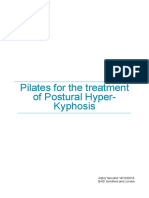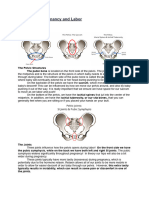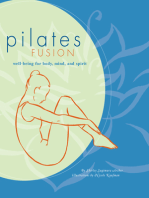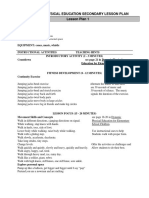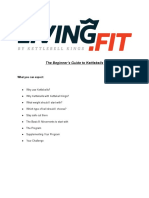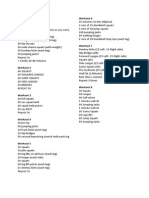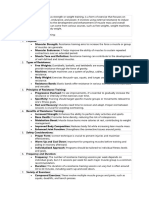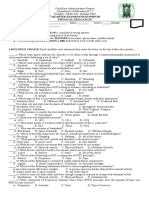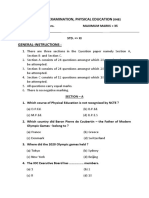Week 4 Notes - Pelvis Anatomy and Biomechanics
Uploaded by
cafeWeek 4 Notes - Pelvis Anatomy and Biomechanics
Uploaded by
cafe1
Empowered Performance Program
Week 4 Notes
Pelvis Anatomy and Biomechanics
Superior to Inferior View of Asymmetrical Compensatory Pelvis and Shoulders
● Everyone will have this base asymmetry but add layers of compensation on.
● How is someone trying to turn back to the left?
● Where are they pushing forward or pulling back?
Pelvic Floor Video
Katie St.Clair Fitness, Empowered Performance Program, 2023
2
PELVIC DIAPHRAGM
❖ Supports the bladder, uterus, intestines.
❖ Aids in the management of intra abdominal pressure.
❖ Is funnel shaped with 3 main components.
➢ Levator Ani - Anterior muscles
■ Puborectalis - relaxes during defecation, helps with urinary
continence (sneezing)
■ Pubococcygeus - controls urine flow, contracts during orgasm
■ Iliococcygeus - elevates pelvic floor and anorectal canal
➢ Coccygeus - Posterior muscles
■ Supports organs and closes off backside of pelvis
➢ Fascia - covers pelvic organs and muscles
PELVIC FLOOR VIDEO
Katie St.Clair Fitness, Empowered Performance Program, 2023
3
PELVIS BIOMECHANICS AND ANATOMY
POSITION 1
❖ Illiums in external rotation / anterior rotation / anterior tilt (possible anterior or
posterior orientation as well of entire pelvis)
❖ Femur in external rotation relative to center of mass but internal rotation relative
to the ilium
❖ Pelvic outlet is more narrow - Narrow Infrapubic Angle (IPA)
❖ Pelvic inlet is more wide
❖ Anterior Pelvic diaphragm is lengthened.
❖ Posterior Pelvic diaphragm is shortened.
❖ Sacrum is counter nutated (makes it easier to squat)
❖ Typical of a compensatory Narrow Infrasternal Angle (ISA)
Concentric / Shortened Muscles
Glute Max
Posterior Pelvic Floor / Coccygeus
Piriformis
Gamellus
Quadratus Femoris
TFL
Psoas
Eccentric / Lengthened Muscles
Hamstring
Iliacus
Glute Med
Anterior Pelvic Floor / Levator Ani
Iliococygeus
Pubococygeus
Puborectalis
Abdominals
Adductors (ischiocondylar portion)
Obturator / inferior medial fibers
Iliacus
Katie St.Clair Fitness, Empowered Performance Program, 2023
4
RESTORING POSITION
❖ Limited In Internal Rotation, Extension, Adduction at the Hip
➢ Need Orientation First
■ Hamstrings and Abs
➢ Need Adduction
■ Will drive Internal Rotation
■ Pulls Pelvic Outlet Open
❖ Hip Shift at 90
➢ Drive Internal Rotation and Nutation
❖ Stacked Position
➢ Drive Extension and Posterior Orientation
➢ Heel Elevated, FFE
❖ Mid Range of Squat Variation
➢ Drives IR and Nutation
❖ Block Squeeze or Band in Adduction
➢ Adduction and Reference
Other possible compensations
❖ Excessive Internal Rotation - Pelvis is very externally rotated and femoral head pushes
forward creating laxity
➢ May feel pinching in the hip (FAI)
➢ May have a femur that is relatively in more IR
■ Need to open the back of the pelvis and posterior pelvic floor release to
shift femur back
■ May need abduction to create stability at the hip in 90 degrees of flexion
positions.
❖ Limited in External Rotation - Femur is in relative ER and external rotators are
concentric
➢ Potentially more of a sway back posture or tendency to clench glutes
■ Need to open the back of the pelvis and posterior pelvic floor
■ May need adduction to drive relative femoral IR
Katie St.Clair Fitness, Empowered Performance Program, 2023
5
POSITION 2
❖ Iliums in internal rotation / posterior rotation (possible anterior or posterior
orientation as well of entire pelvis)
❖ Femur in internal rotation relative to center of mass, external rotation relative to
illium
❖ Pelvic outlet is more wide - Wide Infrapubic Angle (IPA)
❖ Pelvic inlet is more narrow.
❖ Anterior Pelvic diaphragm is shortened.
❖ Posterior Pelvic diaphragm is lengthened.
❖ Sacrum is nutated (makes it easier to hinge)
❖ Typical of a compensatory Wide Infrasternal Angle (ISA)
Eccentric / Lengthened Muscles
Glute Max
Posterior Pelvic Floor / Coccygeus
Piriformis
Gamellus
Quadratus Femoris
TFL
Psoas
Concentric / Shortened Muscles
Hamstring
Iliacus
Glute Med
Anterior Pelvic Floor / Levator Ani
Iliococygeus
Pubococygeus
Puborectalis
Abdominals
Adductors (ischiocondylar portion)
Obturator / inferior medial fibers
Iliacus
Katie St.Clair Fitness, Empowered Performance Program, 2023
6
RESTORING POSITION
❖ Limited In External Rotation, Flexion, ABduction at the Hip
➢ Need Orientation First
■ Hamstrings and Abs
➢ Need ABduction
■ Will drive External Rotation
■ Pulls Pelvic Inlet Open
❖ Hip Shift / Hike with <30 Degrees of Flexion
➢ Drive External Rotation and Counternutation
❖ Stacked Position
➢ If in Anterior Orientation will Restore Posterior Orientation
➢ Heel Elevated, FFE
❖ 0-60 and >120 of Squat Variation
➢ Drives ER and Counternutation
❖ Band in Abduction (around the knees)
➢ ABduction and Reference
Other possible compensations
❖ Limited In Internal Rotation, femur in relative ER
➢ Posterior pelvis and glutes are concentric
➢ Usually will see a limitation in both ER and IR
■ Need to open the back of the pelvis and posterior pelvic floor
■ Need to drive femoral IR and Ilium ER
❖ Limited in Internal Rotation, femur in relative IR
➢ Pelvis is in an anterior orientation
➢ No more IR available because they are at end range IR
■ Need to get pelvis in a better orientation (stack)
■ May need to drive femoral ER if orientation doesn’t create relative ER.
Katie St.Clair Fitness, Empowered Performance Program, 2023
7
POSITION 3 - ASYMMETRICAL
Combination of position 1 and 2 on opposite sides
Katie St.Clair Fitness, Empowered Performance Program, 2023
8
ATTACHMENTS OF MUSCLES
Sacrum to Pelvis
❖ Longissimus Thoracis
❖ Iliocostalis
❖ Latissimus Dorsi
❖ Gluteus Maximus
❖ Levator Ani - Pubococcygeus
❖ Iliacus (at ala)
Sacrum to Femur
❖ Piriformis
❖ Glute Max
❖ Iliacus
Pelvis to Femur
❖ Iliacus
❖ Obturator
❖ Adductors
❖ Psoas
❖ Pectineus
❖ Gracillis
❖ Glutes
❖ Superior Gamellus
❖ Hamstrings
❖ Quadratus Femoris
❖ TFL
Katie St.Clair Fitness, Empowered Performance Program, 2023
9
THE SACROILIAC JOINT
❖ If we view the sacroiliac joint as the center point between the axial and
appendicular skeleton we can view it as the shock absorber between these two
points. Just like pronation and supination of the foot the SI Joint is absorbing
force and rebounding.
❖ As we are in a position of more load / position 2 (mid propulsion / mid stance)
we are more nutated due to gravitational forces being managed. During late and
early propulsion / position 1, we are in more counternutation. THIS IS GAIT.
❖ We should also consider that gait requires the sacrum to nutate on one side and
counternutate on the other so we can develop compensations of a more
asymmetrical nature.
VIDEO OF SI MOVEMENT
WHAT HAPPENS IF WE GET STUCK?
If we get stuck in position 1 or 2 we will have a hard time reciprocally moving in gait, and
performing activities like squats, lunges and deadlifts that require us to move through
changes of pelvis position. Additionally our pelvic diaphragm will have a hard time
eccentrically and concentrically orienting when we need it to.
Due to the asymmetrical nature of the organs and the diaphragm we will often see more
left pelvis anterior rotation (position 1) and more right pelvis posterior rotation (position
2). We can start to see various asymmetrical compensations develop as we continue to
move in this position and manage load in this position.
We can develop different areas of compression of our pelvis (short, tight, concentric
muscles) which will cause limitations in joint range of motion at the sacrum and hips.
Katie St.Clair Fitness, Empowered Performance Program, 2023
10
WHAT DOES TESTING TELL US?
❖ ISA measurement is an indicator of the Infrapubic Angle (IPA). Typically if
someone has compensations, the ISA and IPA will match. Once we know the IPA,
we can make assumptions about the pelvis.
❖ A Narrow ISA is more oriented towards Position 1. A wide ISA is more oriented
towards Position 2 but they still will have the typical asymmetry.
❖ Standing toe touch tell us if they are in anterior orientation or have excessive
hamstring length.
❖ Toe Touch to Squat is also an indicator of their position. Typically Position 1 will
have a much easier time achieving full squat depth due to the sacral
counternutation. It is important to note that they can also be limited due to
compensations higher up. If they have an excessive rib flare and compression on
the back side they likely will be limited in the toe touch to squat.
❖ Standing rotation can also give us an idea of the asymmetrical nature of their
pelvis. If I turn to the left and I am arching my back, it is going to look like I have
a lot more range, but I am getting it by arching my back. I am not getting it by
turning my pelvis over my femur on that side and getting my ribcage to come
back.
❖ Look at someone’s pelvis first and see what’s happening, then look above the
pelvis at the thorax, you’ll see a lot more turn to the left, because they’re arching
their back to turn due to a rib flare.
❖ If they are limited to the right at the thorax in the standing rotation they may also
have a rib flare on the right. If they are also limited to the right at the pelvis they
may not be able to turn the pelvis over the femur on that side or their pelvis is
already turned to the right and can’t go any further.
Katie St.Clair Fitness, Empowered Performance Program, 2023
11
Katie St.Clair Fitness, Empowered Performance Program, 2023
12
Superior to Inferior View of Asymmetrical Compensatory Pelvis and Shoulders
Katie St.Clair Fitness, Empowered Performance Program, 2023
You might also like
- SSTT 7 Week Powerlifting Hypertrophy 2.0 AypyagNo ratings yetSSTT 7 Week Powerlifting Hypertrophy 2.0 Aypyag236 pages
- Week 6 Notes - Compensatory Compression and ExpansionNo ratings yetWeek 6 Notes - Compensatory Compression and Expansion20 pages
- Pilates For The Treatment Fo Postural Hyper Kyphosis PDF100% (1)Pilates For The Treatment Fo Postural Hyper Kyphosis PDF17 pages
- Week 3 - Thorax and Shoulder Anatomy and BiomechanicsNo ratings yetWeek 3 - Thorax and Shoulder Anatomy and Biomechanics42 pages
- Fundamental & Derived Position: StandingNo ratings yetFundamental & Derived Position: Standing6 pages
- Preventing and Managing Back Pain: Handbook100% (2)Preventing and Managing Back Pain: Handbook17 pages
- "Derived Positions" - Amal Hassan Mohammed IbrahimNo ratings yet"Derived Positions" - Amal Hassan Mohammed Ibrahim59 pages
- Week 2 Notes - Seminar Assessment - April 2023No ratings yetWeek 2 Notes - Seminar Assessment - April 202326 pages
- Body Mechanics: Marlon A. de Guzman, PTRP, MOHNo ratings yetBody Mechanics: Marlon A. de Guzman, PTRP, MOH36 pages
- Postural Deformities: Dr. Madhuri P. SadgirNo ratings yetPostural Deformities: Dr. Madhuri P. Sadgir36 pages
- 429 FT0 Physiotherapy in Obstetrics Gynaecology Mohd. Javed100% (1)429 FT0 Physiotherapy in Obstetrics Gynaecology Mohd. Javed86 pages
- Physical Education 01: (Self Testing Activity and Gymnastics) 1 Semester SY: 2020-2021No ratings yetPhysical Education 01: (Self Testing Activity and Gymnastics) 1 Semester SY: 2020-20215 pages
- PHA 618 Laboratory Human Physiology and Pathophysiology: Muscular SystemNo ratings yetPHA 618 Laboratory Human Physiology and Pathophysiology: Muscular System42 pages
- Physiotherapy in Obstetrics GynaecologyNo ratings yetPhysiotherapy in Obstetrics Gynaecology90 pages
- Kine II Derived Positions Part 1 Lec # 8No ratings yetKine II Derived Positions Part 1 Lec # 829 pages
- Scoliosis: Futhri Rifa Zaimsyah, S.TR - FT., M.PhysioNo ratings yetScoliosis: Futhri Rifa Zaimsyah, S.TR - FT., M.Physio42 pages
- Core Strength for 50+: A Customized Program for Safely Toning Ab, Back & Oblique MusclesFrom EverandCore Strength for 50+: A Customized Program for Safely Toning Ab, Back & Oblique Muscles4.5/5 (2)
- Pathways to a Centered Body: Gentle Yoga Therapy for Core Stability, Healing Back Pain, and Moving With EaseFrom EverandPathways to a Centered Body: Gentle Yoga Therapy for Core Stability, Healing Back Pain, and Moving With EaseNo ratings yet
- SPEAKING PART 1 60 MOST IMPORTANT TOPICSNo ratings yetSPEAKING PART 1 60 MOST IMPORTANT TOPICS59 pages
- Dynamic Physical Education Secondary Lesson Plan Lesson Plan 1No ratings yetDynamic Physical Education Secondary Lesson Plan Lesson Plan 12 pages
- Bodyweight Hoplite - Build A Lean and Mean Physique With Only Your Own Body PDFNo ratings yetBodyweight Hoplite - Build A Lean and Mean Physique With Only Your Own Body PDF9 pages
- Past Continuous All Forms Mixed Exercise 2No ratings yetPast Continuous All Forms Mixed Exercise 23 pages
- Resistance-Training Final-Coverage RevisedNo ratings yetResistance-Training Final-Coverage Revised3 pages
- 8 Class Workshop Series "Keeping Up Without Coffee"No ratings yet8 Class Workshop Series "Keeping Up Without Coffee"8 pages
- Exercises: Comprehension Test On Meeting 11: Listening - Short Conversation: Idioms0% (2)Exercises: Comprehension Test On Meeting 11: Listening - Short Conversation: Idioms2 pages
- Longmont Recreation Summer 2020 BrochureNo ratings yetLongmont Recreation Summer 2020 Brochure53 pages
- Profit Report: Weight Loss Trackers / JournalsNo ratings yetProfit Report: Weight Loss Trackers / Journals5 pages
- Male Multiple Orgasm_ the Ultimate Guide on Becoming a Multi-Orgasmic Man [Gain Ultimate Control - Get More Pleasure - Give More Pleasure] ( PDFDrive )No ratings yetMale Multiple Orgasm_ the Ultimate Guide on Becoming a Multi-Orgasmic Man [Gain Ultimate Control - Get More Pleasure - Give More Pleasure] ( PDFDrive )62 pages
- Aerobic Capacity Program-Avery ArchuletaNo ratings yetAerobic Capacity Program-Avery Archuleta3 pages
- Basic Concepts of Sports Components of Physical Fitness Classification of SportNo ratings yetBasic Concepts of Sports Components of Physical Fitness Classification of Sport33 pages
- First Term Examination, Physical EducationNo ratings yetFirst Term Examination, Physical Education16 pages
- Cambridge IGCSE: Physical Education 0413/13No ratings yetCambridge IGCSE: Physical Education 0413/1316 pages













